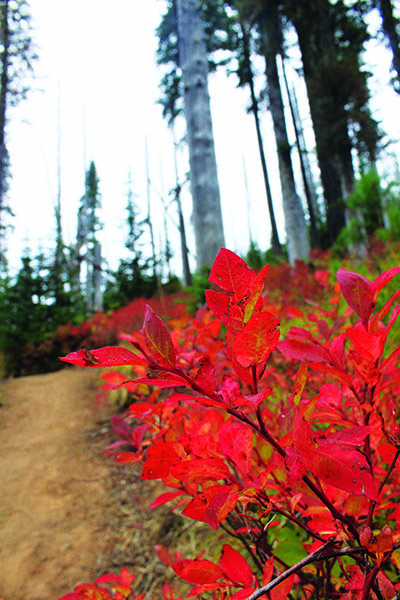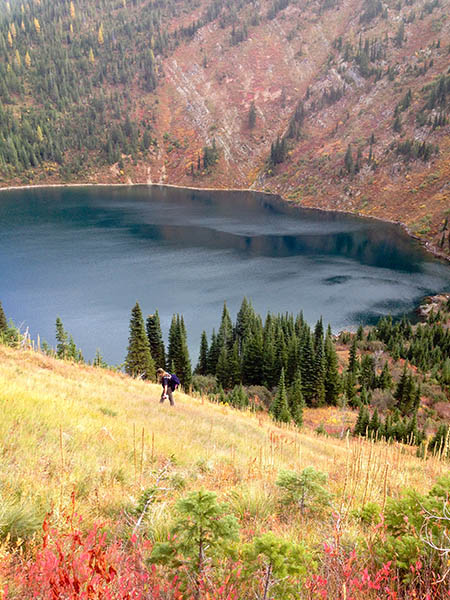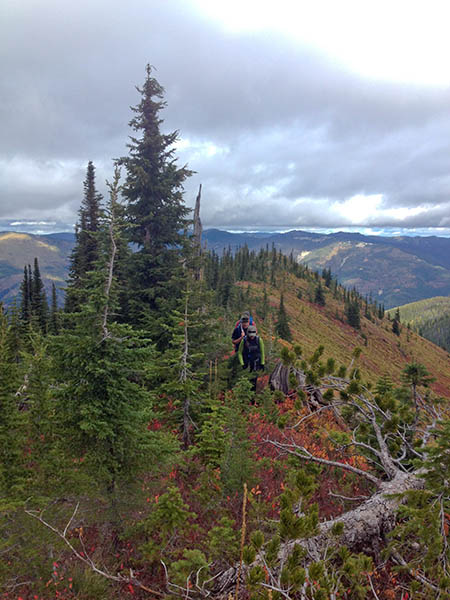By Derrick Knowles, Holly Weiler, Amy McCaffree, and Chic Burge
Hiking under still, silent ski lifts at the local resort may not strike you as the best place for a fall hike, but consider these reasons for giving it a try if you never have.
Looking for views and spectacular fall colors? The high peaks and open slopes of ski resorts and adjacent mountains and ridges can offer up priceless views of the landscapes below in the midst of their annual fall color make-over. And brushy ski slopes filled with huckleberry and other shrubs can create a spectacle of fall foliage like nowhere else if you time it right.
If you are a skier or snowboarder, hiking where you ski or ride is also a fun way to experience those wintery places you love so much in a whole new way, and it helps build the stoke for the coming season. And finally, during the modern rifle hunting season, hiking in or around a ski area can be a much safer alternative to tromping through the forested hunting grounds down below.
Enjoy these and other hikes in and around our region’s ski resorts and soak up the short-lived sights, sounds and smells of autumn before the snow flies. (Derrick Knowles)
Mt. Spokane
When Francis Cook called Mount Spokane his summer home in the early 1900s, he met would-be hikers, arriving at his door via horse-drawn wagon, and demanded a 50-cent toll for the privilege of hiking the steep trail between his cabin and Mount Spokane’s scenic summit. Today’s visitor to Mount Spokane State Park may find it easier to gain the summit via passenger car, then hike the old pack trail in reverse to the site of Cook’s former home.
The steep .75 mile trail is accessible from near the Boy Scout-installed lake markers at the summit. The markers indicate the eight lakes, including Eloika to the west and Pend Oreille to the northeast, all visible from Mount Spokane’s summit.
At Paradise Camp, Cook’s cabin is long-gone. The Civilian Conservation Corps-built woodshed is undergoing renovations by the Friends of Mount Spokane State Park, and new informational kiosks have been installed nearby. Take in the history of the site, which was also the location of the old ski lodge that burned to the ground in an electrical fire in 1952.
Complete a loop hike by walking a short distance down the Kit Carson Loop Road to the intersection with upper trail 140, rerouted in the fall of 2013. Turn right and begin the climb back to the summit. The trail is a popular mountain bike and hiking trail in the snow-free months, and is marked with blue diamonds as a winter snowshoe route. It’s a steady uphill to the top, with plenty of opportunities to stop and admire the view while catching one’s breath.
At the summit, don’t miss Vista House, the 1934 native stone summit building, the upper portion of which served as the park’s first fire lookout. Until the ski season starts up again, the lower portion of the building is open to the public as a picnic area, protected from the fierce summit winds characteristic of the mountain’s top.
When the snow finally returns, do the hike on snowshoes or backcountry skis and bring a few extra bucks for hot cocoa at the winter-only weekend concession stand housed inside the historic building. (Holly Weiler)
Learn about the Mt. Spokane’s skiing history.
49 Degrees North: Chewelah Peak
Around 49 Degrees North Mountain Resort, any of the alpine, Nordic, or snowshoe trails are open for hiking before winter operations begin. Take off from the lodge and keep an eye out for wildlife and fall colors, says John Eminger, the resort’s owner and operator from 1996 to 2019. He recommends picnicking on the lodge deck and exploring any of the trails around the resort’s three basins and two summits.
The Summit Route around the alpine area includes three connective trails. The trailhead for the first one, the Alpine Road Trail – also called East Basin Trail – begins near the lodge parking lots. Follow the trail past Chair 5, which you pass under at the 2K (1.24 miles) mark, and continue until you reach Moose Track Corner (4K/approximately 2.5 miles).
Then you connect with the relatively easy South Face Traverse Trail. Follow this for three miles, enjoying views of the ski area’s backside, until you get to the Summit Trail. Continue for 1.2 mile on a rugged trek through trees to Chewelah Peak (5,775’ elevation). The trail ends near Chair 5, for a total of 7.89 miles. Head straight downhill back to the lodge area for a shorter descent, and keep an eye out for deer, elk, moose, bear and other wildlife.
Also, within the designated Nordic park, there is a network of mostly easy trails more suitable for less ambitious day hikers. Check out the resort/trail map at ski49n.com. (Amy McCaffree)
Lookout Pass: Stevens Lakes to Lone Lake
Most of us who are avid hikers have visited Upper and Lower Stevens Lakes, or even lesser visited Lone Lake next door, near Lookout Pass Ski & Recreation Area. But did you know there’s another route worth the effort? This trip visits both Stevens Lakes but continues on.
Once you’ve reached Upper Stevens Lake, look to the ridge to the west or right at the far end of the lake. The ridge is called Willow Ridge and is spectacular any time of the year. Look for a hiker-created trail, of sorts, or pick your way up the scattered game trails. Head up the side of the hill for the prominent rise along the ridge. The easiest route down to Lone Lake on the other side is located on the north side of this rise.
Over the years, many have ventured to the ridge and on to the summit of Stevens Peak. I suggest that you consider dropping over the ridge down to Lone Lake’s upper alpine bowl (I call it the “Upper Sanctuary”).
In the spring, the Sanctuary is an electric green of many shades. The vivid colors next to the massive rock faces, in contrast with the dark greens of sub-alpine fir, make for amazing images.
During the autumn months, these greens turn brilliant orange, red, and yellow. Upper Stevens Lake and the Lone Lake “Sanctuary” are especially beautiful this time of year.
Once you are down in the Lone Lake basin “Sanctuary,” notice the colors come alive. There are two humps above the small pond there that you can climb up for great views and a high place to photograph from. I would consider hiking into any of these lakes on their own to be moderately difficult, and by summiting, and then dropping into the sanctuary, and back to the same trailhead, this route becomes much more difficult. But don’t let that stop you. It’s simply too amazing to miss. (Chic Burge)
Originally published as “Hiking Where We Ski: Fall Hikes In Ski Country“ in the October-November 2015 print issue of Out There.
[Updated: Sept. 2021]
[Feature photo by Derrick Knowles.]

















